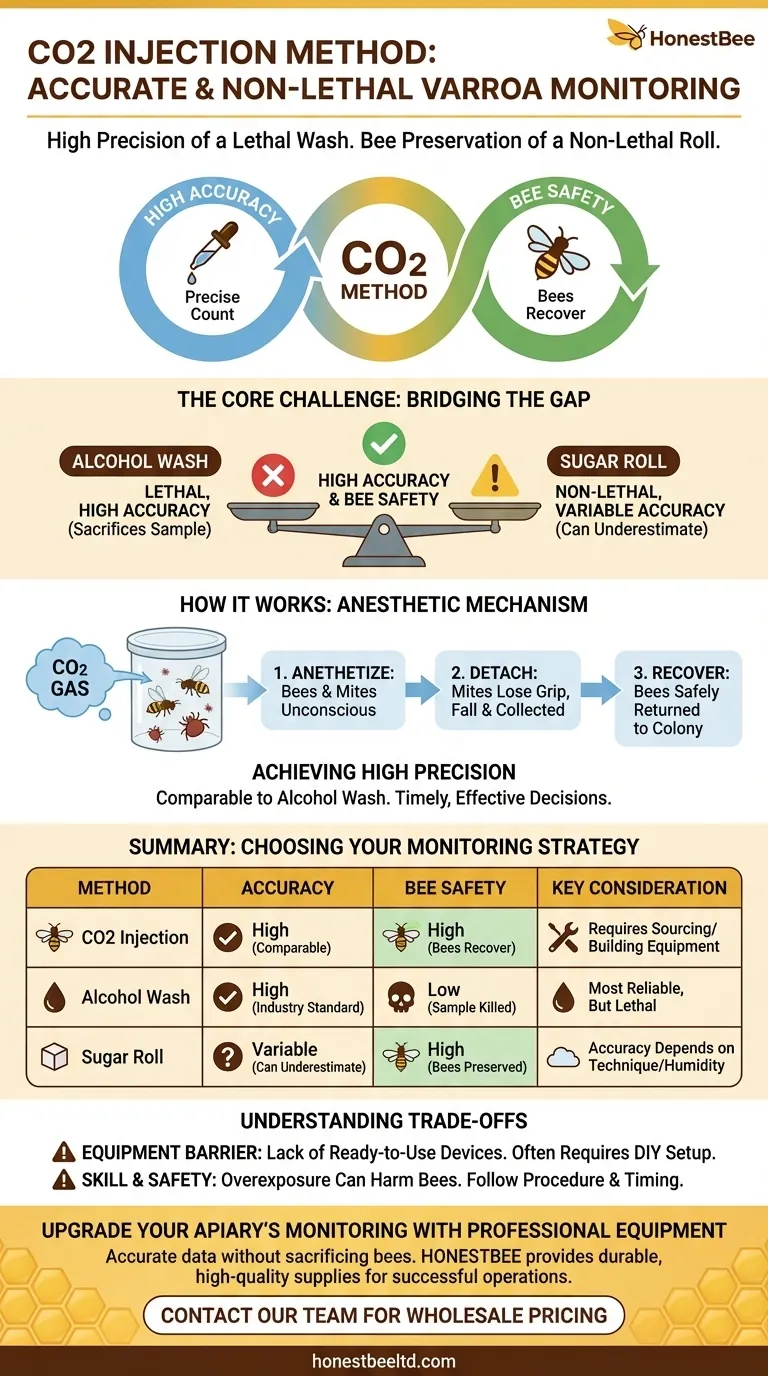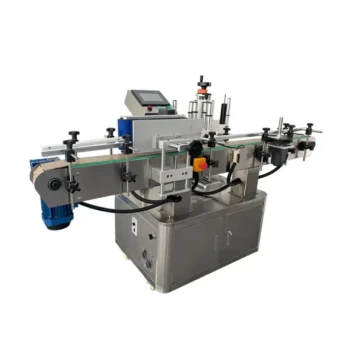The primary benefit of the CO2 injection method for varroa monitoring is its unique ability to deliver the high accuracy of a lethal alcohol wash without killing the sample of bees. It anesthetizes both the bees and the mites, causing the mites to detach for an easy and precise count, after which the bees can be safely returned to the colony.
While beekeepers have historically faced a trade-off between the accuracy of lethal methods and the bee preservation of less reliable ones, the CO2 injection method resolves this conflict. It offers a powerful diagnostic tool that combines high precision with non-lethality.

The Core Challenge: Accuracy vs. Bee Safety
Effective varroa management begins with accurate monitoring. However, the most common methods have traditionally forced beekeepers into a difficult choice.
The Gold Standard: The Alcohol Wash
The alcohol wash is widely considered the most accurate and reliable method for determining varroa mite levels.
Submerging a bee sample in alcohol quickly kills both bees and mites, ensuring nearly all mites detach for a precise count. The major drawback is the sacrifice of several hundred bees for each test.
The Non-Lethal Alternative: The Sugar Roll
The sugar roll method was developed as a way to monitor mites without harming the bees. Bees are rolled in powdered sugar, which encourages mites to lose their grip.
While this method preserves the bee sample, its accuracy can be inconsistent. Results are often influenced by ambient humidity and variations in user technique, potentially leading to an underestimation of the true mite load.
How CO2 Injection Bridges the Gap
The CO2 injection method provides a third way, capturing the primary benefits of the other two methods while minimizing their drawbacks.
The Anesthetic Mechanism
The process involves briefly exposing a sample of bees to a concentrated atmosphere of carbon dioxide. This gas acts as a temporary anesthetic, rendering both the bees and the varroa mites unconscious without causing permanent harm.
Why Mites Detach
Once anesthetized, the varroa mites lose their grip on their bee hosts. A few gentle shakes of the container are all that is needed to dislodge the unconscious mites, allowing them to be collected and counted.
Achieving High Precision
Multiple studies confirm that the CO2 method's precision is comparable to the alcohol wash. This reliability gives beekeepers high-quality data to make timely and effective treatment decisions, just as they would with a lethal wash.
Understanding the Trade-offs
No method is without its challenges. While highly effective, the CO2 method has practical considerations that have slowed its widespread adoption.
The Equipment Barrier
The primary obstacle is the lack of affordable, commercially available, ready-to-use devices. Beekeepers interested in this method often need to assemble their own testing kits using CO2 cartridges (like those for bike tires or soda makers) and a specialized container.
Skill and Bee Safety
The process is generally safe for worker bees when performed correctly. However, overexposure to CO2 can harm or kill the bees, so it is critical to follow a tested procedure and time the exposure carefully. The bees typically recover within minutes of being returned to open air.
Making the Right Choice for Your Goal
Selecting a monitoring strategy depends on your specific goals, resources, and beekeeping philosophy.
- If your primary focus is maximum accuracy and cost-effectiveness: The alcohol wash remains the simplest and most reliable industry standard, assuming the loss of the bee sample is acceptable.
- If your primary focus is bee preservation above all: The sugar roll is a valid, low-cost approach, but practice your technique and be mindful that it may underestimate mite loads.
- If your primary focus is combining high accuracy with bee safety: The CO2 method is the superior choice, provided you are willing to source or build the necessary equipment.
Ultimately, choosing a reliable monitoring tool is the foundation of proactive and successful hive management.
Summary Table:
| Method | Accuracy | Bee Safety | Key Consideration |
|---|---|---|---|
| CO2 Injection | High (Comparable to Alcohol Wash) | High (Bees Recover) | Requires sourcing/building equipment |
| Alcohol Wash | High (Industry Standard) | Low (Sample is Killed) | Most reliable but lethal |
| Sugar Roll | Variable (Can Underestimate) | High (Bees Preserved) | Accuracy depends on technique/humidity |
Upgrade Your Apiary's Monitoring with Professional Equipment
Accurate varroa monitoring is non-negotiable for healthy, productive hives. The CO2 method provides the data integrity you need without sacrificing your bees. As a trusted wholesale supplier to commercial apiaries and equipment distributors, HONESTBEE provides the durable, high-quality beekeeping supplies that form the backbone of a successful operation.
Let us help you build a more efficient and sustainable monitoring protocol. Contact our team today to discuss your equipment needs and wholesale pricing.
Visual Guide

Related Products
- Full Set Beekeeping Electronic Bee Venom Collector Machine Device for Bee Venom Collecting
- Queen Bee Artificial Insemination Instrument Equipment for Instrumental Insemination
- Metal Wick Holder Centering Devices for DIY Candle Making Candle Wick Holder
- HONESTBEE Professional Telescopic Pole Bee Swarm Catcher
- Circular Labyrinth Bee Escape for Efficient Hive Management
People Also Ask
- How frequently should pollen be harvested from the traps? Ensure Optimal Hive Health & Superior Quality
- How frequently should pollen be collected for human consumption? Optimize Your Harvesting Schedule
- What are the precautions for handling dry bee venom? Essential Safety Protocols for Beekeepers
- How is the venom collection apparatus utilized across multiple hives? A Guide to Efficient Rotation & Bee Health
- How many hives are needed on average to collect 1 gram of bee venom? A Guide to Low-Yield Harvesting



















